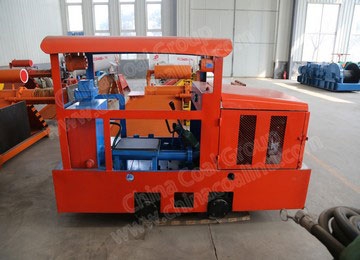High-Performance Electric Locomotives: Strength Meets Sustainability
Date:2025-03-25 Label:
Electric Locomotive
Diesel Locomotive
Underground Mining Locomotive
Trolley Locomotive
Battery Locomotive
Narrow Gauge Locomotive
Explosion-proof Mining Locomotive
Overview
An
electric locomotive is a railway vehicle that draws power from an external electricity source (such as overhead lines or third rails) to drive its traction motors. Unlike diesel locomotives, electric locomotives produce no direct emissions, making them more environmentally friendly and efficient for rail transport.
electric locomotives are widely used in passenger and freight services, particularly in urban metro systems, high-speed rail networks, and heavy-haul freight operations.

Key Components
Pantograph – A retractable apparatus that collects electricity from overhead catenary wires.
Traction Motors – Electric motors (usually AC induction or permanent magnet motors) that drive the wheels.
Transformer & Rectifier/Converter – Steps down high-voltage AC from the power line and converts it to a usable form (DC or variable-frequency AC).
Control System – Manages power distribution, acceleration, braking, and energy efficiency.
Regenerative Braking – Recovers kinetic energy during braking and feeds it back into the power grid or onboard storage.
Bogies (Trucks) – Chassis assemblies that house wheels, motors, and suspension systems.
Power Supply Systems
Electric locomotives operate using different electrification standards:
Direct Current (DC) Systems – Common in older systems (e.g., 600V, 1.5kV, 3kV).
Alternating Current (AC) Systems – Modern networks typically use 15kV, 16.7Hz (Europe) or 25kV, 50Hz (Asia, UK, and high-speed rail).
Dual-Voltage Locomotives – Can switch between different power systems for cross-border operations.
Advantages of
electric locomotives
Higher Efficiency – Converts over 90% of energy into motion, compared to ~30-35% for diesel.
Lower Operating Costs – Reduced fuel and maintenance expenses.
Zero Direct Emissions – Ideal for urban and underground rail networks.
Greater Power & Acceleration – Suitable for high-speed and heavy freight trains.
Regenerative Braking – Recovers energy, improving overall efficiency.
Types of Electric Locomotives
Passenger Locomotives – Designed for speed and smooth operation (e.g., Siemens Velaro, Shinkansen E5 Series).
Freight Locomotives – Built for high tractive effort and hauling capacity (e.g., GE Evolution Series, Chinese HXD1).
High-Speed Trains – Optimized for speeds over 250 km/h (155 mph) (e.g., TGV, ICE, CRH Harmony).
Metro & Light Rail Units – Used in urban transit systems (e.g., Bombardier MOVIA, Kawasaki MTA R211).
Future Trends
Battery-Electric & Hybrid Locomotives – Reducing dependency on continuous electrification.
Higher Voltages & Smart Grids – Improving energy efficiency and reducing losses.
Autonomous & AI-Driven Trains – Automation for better scheduling and energy management.
Expansion of Electrified Rail Networks – More countries transitioning from diesel to electric.
Conclusion
Electric locomotives are a cornerstone of modern rail transport, offering superior efficiency, lower emissions, and high performance. As technology advances, they will play an even greater role in sustainable transportation worldwide.